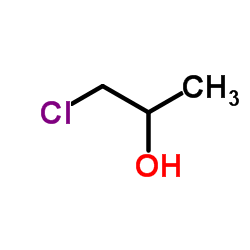1-Chloro-2-propanol

1-Chloro-2-propanol structure
|
Common Name | 1-Chloro-2-propanol | ||
|---|---|---|---|---|
| CAS Number | 127-00-4 | Molecular Weight | 94.540 | |
| Density | 1.1±0.1 g/cm3 | Boiling Point | 126.5±0.0 °C at 760 mmHg | |
| Molecular Formula | C3H7ClO | Melting Point | N/A | |
| MSDS | Chinese USA | Flash Point | 54.5±15.3 °C | |
| Symbol |


GHS02, GHS06 |
Signal Word | Danger | |
|
NTP Toxicology and Carcinogenesis Studies of 1-Chloro-2-propanol (Technical Grade) (CAS NO. 127-00-4) in F344/N Rats and B6C3F1 Mice (Drinking Water Studies.
Natl. Toxicol. Program Tech. Rep. Ser. 477 , 1-264, (1998) 1-Chloro-2-propanol and its positional isomer, 2-chloro-1-propanol, are used as chemical intermediates for the manufacture of propylene oxide, a starting material for production of polyurethane polyols and propylene glycol. The National Cancer Institute nomin... |
|
|
Chemical mutagenesis testing in Drosophila. IX. Results of 50 coded compounds tested for the National Toxicology Program.
Environ. Mol. Mutagen. 23(1) , 51-63, (1994) Fifty chemicals were tested for mutagenic activity in post-meiotic and meiotic germ cells of male Drosophila melanogaster using the sex-linked recessive lethal (SLRL) assay. As in the previous studies in this series, feeding was chosen as the first route of a... |
|
|
Haloperoxidases: Enzymatic Synthesis of alpha,beta-Halohydrins from Gaseous Alkenes.
Appl. Environ. Microbiol. 45(2) , 366-74, (1983) The enzymatic synthesis of alpha,beta-halohydrins from gaseous alkenes is described. The enzymatic reaction required an alkene, a halide ion, dilute hydrogen peroxide, and a haloperoxidase enzyme. A wide range of gaseous alkenes were suitable for this reactio... |
|
|
Preferential attack of the (S)-configured ether-linked carbons in bis-(1-chloro-2-propyl) ether by Rhodococcus sp. strain DTB.
FEMS Microbiol. Ecol. 55(1) , 113-21, (2006) Rhodococcus sp. strain DTB (DSM 44534) was grown on a mixture of (R,R)-, (S,S)- and meso-bis-(1-chloro-2-propyl) ether (BCPE) as the sole source of carbon and energy. During BCPE degradation 1'-chloro-2'-propyl-3-chloro-2-prop-1-enyl-ether (DVE), 1-chloro-2-p... |
|
|
Reproductive toxicology. 1-Chloro-2-propanol.
Environ. Health Perspect. 105 Suppl 1 , 291-2, (1997)
|
|
|
1,2-Dichloropropane: metabolism and fate in the rat.
Xenobiotica 10(11) , 835-46, (1980) 1. The metabolism of 1,2-dichloropropane in the rat has been investigated. The major urinary metabolite has been isolated and identified as N-acetyl-S-(2-hydroxypropyl)cysteine. Two minor metabolites of 1,2-dichloropropane have been identified as beta-chlorol... |
|
|
Mutagenicity of chloropropanol in a genetic screening battery.
Fundam. Appl. Toxicol. 3(1) , 27-33, (1983) A 72:25 mixture of 1-chloro-2-propanol and 2-chloro-1-propanol was tested for genetic activity in a battery of short term tests. Chloropropanol was tested over a dose range of 527-167,250 micrograms/plate in the Salmonella/mammalian microsome mutagenicity ass... |
|
|
Propylene chlorohydrins: toxicology, metabolism, and environmental fate.
Rev. Environ. Contam. Toxicol. 99 , 47-59, (1987)
|
|
|
Disposition of inhaled 1-chloro-2-propanol in F344/N rats.
Toxicol. Appl. Pharmacol. 95(3) , 444-55, (1988) Propylene chlorohydrins, of which 1-chloro-2-propanol (1-CP) is a constituent, used as intermediates in the manufacture of propylene oxide and have been identified as potential air pollutants. The objective of these studies was to determine whether changes in... |
|
|
Electrochemical detection of low concentration chloropropanol using silver nanowire array electrodes in aqueous media.
J. Nanosci. Nanotechnol. 11(3) , 2283-6, (2011) In this paper, we report a facile method to fabricate silver nanowire array electrodes (SNAE) with ultra-high detection sensitivity to chloropropanol in the aqueous solution. Silver nanowire arrays were assembled in conventional anodic alumina membranes (AAM)... |